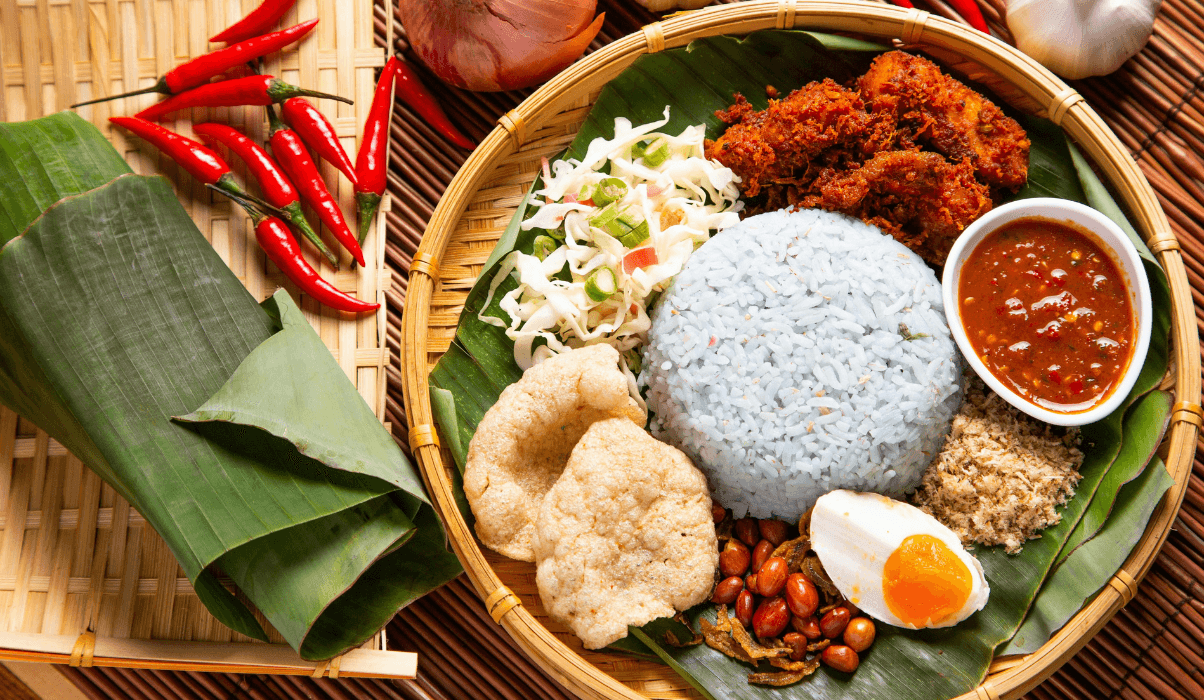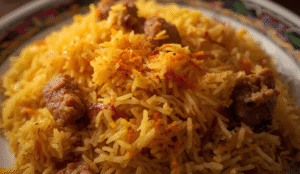Recipe Nasi Lemak Step-by-Step: A True Malaysian Delight
When it comes to iconic Malaysian food, nothing captures the soul of the nation quite like nasi lemak. Known for its fragrant coconut rice, fiery sambal, crispy anchovies, roasted peanuts, hard-boiled egg, and cooling cucumber slices, it’s a dish that’s both simple and rich in culture. In this guide, we’ll walk you through a full recipe nasi lemak step-by-step so you can bring this national treasure into your kitchen.
Whether you’re a local craving a homemade version or a global foodie looking to explore Southeast Asian cuisine, this recipe nasi lemak guide will help you prepare an authentic plate that captures all the flavors Malaysia is known for.
Frequently Asked Question (FAQ):
1. What are the ingredients for nasi lemak?
To prepare a traditional recipe nasi lemak, you’ll need jasmine rice, coconut milk, water, salt, and pandan leaves for the rice. The classic accompaniments include hard-boiled eggs, crispy fried anchovies (ikan bilis), roasted peanuts, sliced cucumber, and spicy sambal. These components come together to create the complete nasi lemak Malaysia recipe that Malaysians love.
2.What are the ingredients in nasi lemak sauce?
The sambal sauce is the heart of any recipe nasi lemak. To make authentic recipe sambal, you’ll need dried chilies, fresh red chilies, shallots, garlic, belacan (fermented shrimp paste), tamarind paste, sugar (palm or brown sugar), salt, and sliced onions. The sambal is slow-cooked until it turns dark red and aromatic, creating a perfect spicy-sweet balance.
3. What is vegetarian nasi lemak?
Vegetarian nasi lemak is a meat-free version of the traditional Malaysian dish recipe. Instead of anchovies and egg, vegetarians can enjoy the coconut rice with sambal made without belacan, along with sides like stir-fried tofu, tempeh, peanuts, cucumber, and vegetarian curry or rendang. It retains the comforting essence of the recipe nasi lemak while catering to plant-based diets.
4. What to serve with nasi lemak?
There are many delicious sides to enhance your recipe nasi lemak. Popular options include ayam goreng berempah (spiced fried chicken), rendang, sambal squid (sambal sotong), curry vegetables, or kerabu salad. These flavorful dishes add variety, texture, and spice—turning your nasi lemak Malaysia recipe into a feast.
5. Can you make nasi lemak without pandan?
Yes, you can make recipe nasi lemak without pandan leaves. While pandan adds a fragrant, floral aroma that enhances the coconut rice, it’s not a strict requirement. You can still create a delicious Malaysian dish recipe using coconut milk, salt, and high-quality rice. If pandan is unavailable, bay leaves or lemongrass can be mild substitutes.
The Cultural Story Behind Nasi Lemak
No discussion of recipe nasi lemak is complete without understanding its cultural roots. The term “nasi lemak” directly translates to “rich or creamy rice” in Malay, referencing the luxurious taste of the coconut-infused rice. The dish originated as a farmers’ meal—something hearty and energy-packed for laborers working in the fields.
Over time, it evolved into a national icon. Today, you can find nasi lemak Malaysia recipe versions in every corner of the country—from simple banana leaf-wrapped breakfasts in roadside stalls to high-end renditions with lobsters and soft-boiled eggs in gourmet restaurants.
This humble yet versatile dish is more than just a Malaysian dish recipe. It’s a symbol of unity, served during school canteen breaks, family gatherings, corporate events, and festive holidays.
Why Nasi Lemak is the Heart of Malaysia
Nasi lemak isn’t just food—it’s an emotion. Found on street corners, at roadside stalls, and in five-star hotels, it’s a Malaysian dish recipe that transcends social and cultural boundaries. You’ll find locals eating it for breakfast, lunch, dinner, or even supper. It’s versatile and deeply rooted in the Malaysian way of life.
The dish represents the fusion of Malaysia’s diverse communities—Malay, Chinese, Indian, and Indigenous groups—all enjoying and embracing the same meal with slight variations.
Exploring Regional Sambal Styles
Sambal is the soul of any recipe nasi lemak. Different regions in Malaysia have their unique twist on this spicy chili paste, which gives a new dimension to the dish every time:
A sweet and mildly spicy version made with shallots, anchovies, and palm sugar. It’s great for beginners trying their first recipe sambal at home.
This version leans heavily into dried shrimp or small prawns, offering a more pungent and brinier flavor.
Here, you’ll find sambal made with dried tamarind skins and torch ginger flower (bunga kantan), adding a floral and sour aroma to the nasi lemak Malaysia recipe.
No matter the style, preparing the sambal from scratch elevates your recipe nasi lemak to a truly authentic level.
Unique to the East Coast, this sambal incorporates mashed ikan bilis (anchovies) or sardines, simmered with tamarind and sugar. The result is a salty-sweet flavor that gives a bolder twist to your nasi lemak Malaysia recipe.
In Perak and Negeri Sembilan, sambal with dried shrimp adds a savory depth that clings beautifully to coconut rice. It’s umami-rich and particularly popular among sambal lovers who enjoy a stronger seafood kick in their Malaysian dish recipe.
Made from green chilies, green tomatoes, and sometimes anchovies, this sambal is popular in modern fusion nasi lemak dishes. It’s tangy, spicy, and slightly earthy—a great twist on the traditional recipe sambal.
Each of these sambals offers a new way to enjoy the same beloved dish, giving you endless creative possibilities with your recipe nasi lemak.
Nasi Lemak as Malaysia’s National Identity
If there’s a single dish that unites all Malaysians, it’s definitely nasi lemak. In fact, in 2016, TIME Magazine named it one of the 10 healthiest international breakfasts (if eaten in moderation!). This recognition further highlighted the global appeal of the humble recipe nasi lemak.
But beyond health trends and foodie fame, nasi lemak represents:
- Unity in Diversity: You’ll find Malays, Chinese, Indians, and Indigenous communities all enjoying it, sometimes with slight tweaks to suit cultural tastes.
- Daily Routine: It’s not just for special occasions. Students, office workers, and marketgoers grab it as a go-to morning fuel.
- Culinary Pride: Whether you’re using a simple village version or a luxury twist, the essence of the nasi lemak Malaysia recipe remains consistent—rice, sambal, egg, anchovies, and love.
It’s not just a Malaysian dish recipe; it’s a shared cultural story told through food. From pasar malam (night markets) to gourmet restaurants, nasi lemak reminds Malaysians of home, heritage, and identity.

Ingredients You’ll Need (Serves 4)
Let’s start with the basics. A successful recipe nasi lemak depends on a balance of flavors: rich, spicy, salty, and refreshing. Below are the ingredients you’ll need for each component:
For the Coconut Rice:
- 2 cups of jasmine rice
- 1½ cups coconut milk
- 1½ cups water
- 1 pandan leaf, tied into a knot
- 1 tsp salt
For the Sambal (Spicy Sauce):
- 10 dried chilies, soaked in warm water
- 3 fresh red chilies
- 3 shallots
- 2 cloves garlic
- 1 tsp belacan (shrimp paste)
- 1 tbsp tamarind paste
- 1 tbsp sugar (palm sugar or brown sugar preferred)
- Salt to taste
- 1 onion, sliced thin (for caramelizing)
This is the heart of our recipe sambal, which gives nasi lemak its unforgettable heat and flavor.
Accompaniments:
- 4 hard-boiled eggs
- 1 cup fried anchovies (ikan bilis)
- 1 cup roasted peanuts
- 1 cucumber, thinly sliced
Step-by-Step Cooking Instructions
Step 1: Prepare the Coconut Rice
The base of any recipe nasi lemak is the coconut rice. This step ensures your rice is fluffy, aromatic, and full of that creamy coconut flavor.
- Wash the jasmine rice until the water is clear.
- Combine coconut milk, water, pandan leaf, and salt in a rice cooker or pot.
- Add the rice and stir gently.
- Cook on a low simmer until done or simply use a rice cooker and let it handle the rest.
- Once done, fluff the rice with a fork and let it rest for 10 minutes.
The aroma from the pandan and coconut milk is essential to the overall success of your nasi lemak Malaysia recipe.
Step 2: Make the Sambal
This fiery chili paste is what sets your recipe nasi lemak apart. A good sambal should balance heat, sweetness, tanginess, and depth.
- Blend the dried chilies, fresh chilies, shallots, garlic, and belacan into a smooth paste.
- Heat oil in a pan and sauté the paste until fragrant (about 7-10 minutes).
- Add tamarind paste and sugar.
- Stir in sliced onions and continue cooking until the sambal darkens and the oil begins to separate.
- Season with salt to taste.
This is the ultimate recipe sambal that complements the richness of coconut rice.
Step 3: Prepare the Sides
No recipe nasi lemak is complete without its signature sides. Each element adds texture and balance.
- Boil the eggs until hard, then peel half.
- Dry-fry or roast the peanuts until golden and crunchy.
- Fry the anchovies until crispy and set them aside.
- Slice cucumbers into thin rounds for a fresh, cool bite.
These sides don’t just add taste—they provide visual contrast and nutritional value to this Malaysian dish recipe.
Plating the Perfect Nasi Lemak
Now comes the fun part—assembly!
- Place a generous scoop of coconut rice at the center of the plate.
- Spoon a rich amount of sambal on one side.
- Add half a hard-boiled egg.
- Sprinkle a handful of crispy anchovies and peanuts.
- Line with cucumber slices for a refreshing finish.
Some may prefer to serve this recipe nasi lemak on banana leaves for an authentic touch. This not only enhances the aroma but also pays homage to traditional Malaysian dining.
Tips for a Perfect Nasi Lemak Experience
- Use pandan leaves: It’s the secret to a more authentic nasi lemak Malaysia recipe.
- Don’t rush the sambal: Slow cooking develops a deeper flavor.
- Balance is key: Ensure the sambal isn’t overly spicy, or it may overpower the dish.
- Customize it: You can add fried chicken, rendang, or even sambal squid for a more luxurious meal.
Variations Across Malaysia
In different parts of the country, recipe nasi lemak comes in local styles:
- Northern Malaysia: Often spicier, with extra anchovies.
- East Malaysia (Sabah & Sarawak): Sometimes served with wild boar curry or different sambal bases.
- Indian-Muslim stalls (Mamak): Usually includes curry chicken or sambal sotong.
Each variation reflects the local palate, but the core of the Malaysian dish recipe remains unchanged.
Why Make Nasi Lemak at Home?
Preparing recipe nasi lemak at home gives you full control over the spice levels, quality of ingredients, and portion sizes. It also connects you to the culture and rhythm of traditional Malaysian cooking. Cooking this meal from scratch offers a deeper appreciation for Malaysia’s culinary heritage.
Nutritional Breakdown (Per Serving)
While indulgent, recipe nasi lemak can be part of a balanced diet when enjoyed mindfully. Here’s an approximate breakdown:
- Calories: 550–700 kcal (depending on sambal and side portions)
- Protein: 15–20g (from egg, peanuts, and anchovies)
- Carbs: 60–75g (mainly from coconut rice)
- Fats: 25–35g (from coconut milk and peanuts)
- Fiber: 4–6g (from cucumber and sambal)
To make it healthier, reduce the oil used in sambal and opt for boiled or grilled proteins. You can still enjoy your favorite recipe nasi lemak without guilt!
How to Store Leftovers (In case if you're wondering)
While best enjoyed fresh, leftovers can be stored:
- Coconut rice: Store in an airtight container in the fridge for up to 2 days.
- Sambal: Keeps in the fridge for up to a week or freeze for longer storage.
- Anchovies and peanuts: Store in airtight containers to retain crispness.
Reheat gently and always serve sambal at room temperature for the best flavor.
Combos Drinks Ideas
Enjoy your recipe nasi lemak with:
- Teh Tarik (Malaysian pulled tea)
- Kopi-O (Black coffee)
- Cendol or Ais Kacang (Traditional desserts)
The richness of the dish pairs perfectly with slightly bitter or sweet Malaysian beverages.
Perfect Pairings: What to Serve with Nasi Lemak
While recipe nasi lemak is often enjoyed on its own, pairing it with other Malaysian favorites can transform your meal into a full gastronomic adventure. Here are more pairing ideas beyond the basics:
The richness of slow-cooked rendang makes it the perfect companion to creamy rice and spicy sambal. This pairing elevates your recipe nasi lemak into a luxury dish often served during celebrations.
This squid-based sambal adds texture and a chewy, spicy surprise. Its bold flavor complements the rice perfectly and is often featured in deluxe nasi lemak Malaysia recipe options.
Lightly stir-fried vegetables like long beans with garlic and belacan add a crunchy, savory side that balances the richness of the dish.
This sweet and spicy tomato-based chicken dish is a great alternative to fried chicken, offering a saucy element to the recipe nasi lemak experience.
Do you want to light things up? Add a tangy Malay-style salad made with raw herbs, onions, lime juice, and grated coconut. It cuts through the richness and freshens your palate.
Including these side dishes not only brings variety but also showcases the diversity and depth of Malaysian cuisine beyond just one Malaysian dish recipe.
Final Thoughts
This recipe nasi lemak step-by-step guide provides everything you need to recreate one of Malaysia’s most beloved dishes. From the fluffy coconut rice to the spicy recipe sambal, each component plays a crucial role. Whether you’re cooking for yourself or hosting a Malaysian-themed dinner, this dish is sure to impress.
Remember, every spoonful is a celebration of Malaysia’s history, culture, and love for food. Don’t be afraid to personalize it and make it your own!





